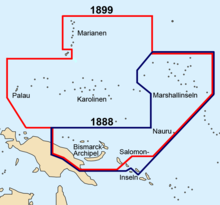Shipping lines through the German South Pacific
The shipping lines by the German South Seas were after acquiring the Palau Islands , the Marianas and the Carolinas in -Spanish German treaty in 1899 as a German mail steamer lines from the German Reich subsidized.
history
The Jaluit Society offered a regular connection not only between Australia and their possessions in Micronesia , but also beyond Jaluit to Ponape and Yap and to Pagan with their steamer Oceana (ex Harold , built in 1891, 684 GRT). From January 1, 1901, the German Reich paid a subsidy for this.
The Munich of North German Lloyd , which was newly hired for service in the German South Seas, was to serve the Yap - Hong Kong line. However, the Munich ran aground on the first voyage on February 3, 1901 in the entrance to Yap and the ship was taken out of service. In return, the Jaluit company extended its line to Hong Kong after the Munich had failed.
After the failure of the Oceana in December 1903, the Germania was used from December 1904 , which made 57 trips by 1914. Her last trip was from Hong Kong on June 12, 1914 via Palau , Yap, Oleai , Saipan , Truk , Ponape , Kosrae to Jaluit (July 11) and on via Nauru , to Rabaul and Sydney (July 30).
In 1904, Norddeutscher Lloyd agreed a new branch of the Reichspostdampferdienst with the Reich government. With the two new ships Prinz Waldemar and Prinz Sigismund , a departure between Hong Kong and Sydney was offered every 12 weeks on the line last used by Munich . In addition to the two “princes”, the steamer Willehad and other steamers were also used on the line. From 1907 these were replaced by the converted, former Brazil steamer Coblenz , which was better suited to the newbuildings. In 1904, Lloyd moved Sumatra to Rabaul in order to offer tourist round trips in the archipelago for travelers on the new Reichspostdampferzweig line between Hong Kong and Sydney (Austral-Japan line) from 1905. In the supplementary agreement with the German government of July 2, 1909, Lloyd took over the so-called island service within the colony of German New Guinea with ancient Sumatra . She was supposed to call at all important places and factories in the colony at intervals of 3 months and regularly made various round trips.
At the request of the colonial administration, an additional branch route from Singapore to New Guinea was set up again in 1908 , on which the Manila drove. It led from Singapore to Batavia , Makassar , Amboina , Banda , Berlinhafen , Potsdamhafen (today Awaro), Alexishafen , Friedrich-Wilhelm-Hafen , Stephansort , Finschhafen , Adolfhafen , Rabaul , Peterhafen to Kavieng . Sometimes even more intermediate ports were called. In 1912 the Manila made 6.5 round trips and had 1,562 passengers. Manila stayed on this service until 1914.
In the months before the outbreak of the First World War in August 1914, negotiations took place with regard to the future of the Reichspostdampferlinien and the subsidies to be granted. The colonial administration pushed for an extension to Apia in order to grant German Samoa a permanent German connection, which had not existed since 1894. North German Lloyd offered such a line, which it wanted to serve with the Manila and her sister ship Sandakan . A contract was no longer concluded.
Individual evidence
literature
- Arnold Kludas : The History of German Passenger Shipping 1850 to 1990 . Ernst Kabel Verlag, 1986.
- Kludas, Arnold: The ships of the North German Lloyd 1857 to 1919 . Koehlers Verlagsgesellschaft, 1991, ISBN 3-7822-0524-3 .
- Reinke-Kunze, Christine: History of the Reichspostdampfer. Connection between the continents 1886–1914 . Koehlers Verlagsgesellschaft, 1994, ISBN 3-7822-0618-5 (3782206185).

